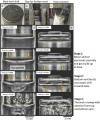Identifying the Cause of Rupture of Li-Ion Batteries during Thermal Runaway
- PMID: 29375967
- PMCID: PMC5770664
- DOI: 10.1002/advs.201700369
Identifying the Cause of Rupture of Li-Ion Batteries during Thermal Runaway
Abstract
As the energy density of lithium-ion cells and batteries increases, controlling the outcomes of thermal runaway becomes more challenging. If the high rate of gas generation during thermal runaway is not adequately vented, commercial cell designs can rupture and explode, presenting serious safety concerns. Here, ultra-high-speed synchrotron X-ray imaging is used at >20 000 frames per second to characterize the venting processes of six different 18650 cell designs undergoing thermal runaway. For the first time, the mechanisms that lead to the most catastrophic type of cell failure, rupture, and explosion are identified and elucidated in detail. The practical application of the technique is highlighted by evaluating a novel 18650 cell design with a second vent at the base, which is shown to avoid the critical stages that lead to rupture. The insights yielded in this study shed new light on battery failure and are expected to guide the development of safer commercial cell designs.
Keywords: Li‐ion batteries; X‐ray CT; high‐speed imaging; thermal runaway; venting.
Figures








References
-
- Nykvist B., Nilsson M., Nat. Clim. Change 2015, 5, 329.
-
- a) Spotnitz R., Franklin J., J. Power Sources 2003, 113, 81.
- b) Ribiere P., Grugeon S., Morcrette M., Boyanov S., Laruelle S., Marlair G., Energy Environ. Sci. 2012, 5, 5271.
- c) Golubkov A. W., Fuchs D., Wagner J., Wiltsche H., Stangl C., Fauler G., Voitic G., Thaler A., Hacker V., RSC Adv. 2014, 4, 3633.
- d) Golubkov A. W., Scheikl S., Planteu R., Voitic G., Wiltsche H., Stangl C., Fauler G., Thaler A., Hacker V., RSC Adv. 2015, 5, 57171.
-
- Finegan D. P., Scheel M., Robinson J. B., Tjaden B., Di Michiel M., Hinds G., Brett D. J. L., Shearing P. R., Phys. Chem. Chem. Phys. 2016, 18, 30912. - PubMed
-
- a) Lamb J., Orendorff C. J., Steele L. A. M., Spangler S. W., J. Power Sources 2015, 283, 517.
- b) Lopez C. F., Jeevarajan J. A., Mukherjee P. P., J. Electrochem. Soc. 2015, 162, A1905.
LinkOut - more resources
Full Text Sources
Other Literature Sources
Research Materials
